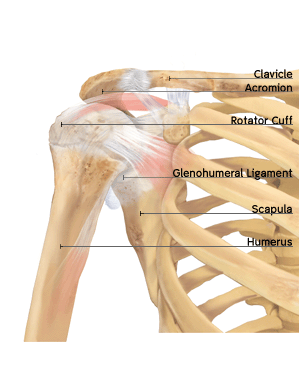|

The shoulder is a ball-and-socket joint and has the greatest range of motion
of any joint in the body. Because of this mobility, it is at risk for injury
or degenerative problems. The bones of the shoulder are the humerus (upper
arm bone), clavicle (collar bone), and scapula (shoulder blade). The head
of the humerus bone (the ball) is lined with cartilage that glides over
the shoulder socket (also known as the “glenoid cavity”). The
clavicle attaches the shoulder to the rib cage and holds the shoulder out
from the body. The scapula is a large triangular bone located on the back
side of the upper body, and it is connected to the clavicle through the
acromioclavicular (AC) joint.
In the shoulder socket, the humerus sits like a golf ball on a tee, supported by a complicated arrangement of muscles, tendons, and ligaments. The rotator cuff is a group of tendons that attaches four shoulder muscles to the upper arm. These tendons help keep the humerus bone in place within its shallow socket and ensure that the arm moves freely within the joint.
>>Continue
|
 |

